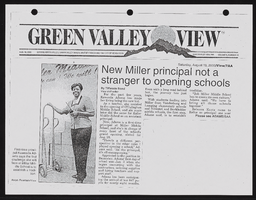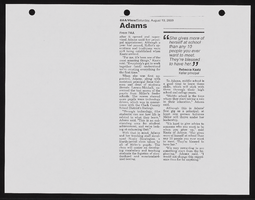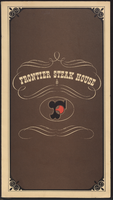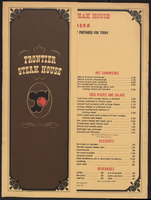Search the Special Collections and Archives Portal
Search Results



Frontier Steak House, dinner menu
Date
Archival Collection
Description
Text

Frontier Steak House, luncheon menu
Date
Archival Collection
Description
Text

Prairie Room, menu
Date
Archival Collection
Description
Text
Sam Jones Letter
Identifier
Abstract
The Sam Jones Letter consists of a one-page letter written on Friday, May 27, 1938 by an unknown individual to Sam Jones, a miner living in Goodsprings, Nevada. The letter identifies a Harold Hawks from Chloride, Arizona, as a fellow miner interested in viewing Jones's property in Nevada.
Archival Collection
University of Nevada, Las Vegas Collection of Transcripts and Journal Articles about Gambling
Identifier
Abstract
Collection contains transcripts from various American television news programs and journal articles about gambling from 1987 to 1992. The topics are broad and include various forms of gambling, problem gambling, and gaming venues.
Archival Collection

Transcript of interview with Brian Cram by Stefani Evans and Claytee White, October 28, 2016
Date
Archival Collection
Description
Throughout his career, former Clark County School District Superintendent (1989–2000) Brian Cram took his father's words to heart. He heard them repeatedly over the years as he watched and later, helped, his father clean classrooms at Robert E. Lake Elementary School: this place—the classroom—this is the most important place. Cram was born in Caliente, where his father worked on the railroad. In 1939, when Cram was a toddler, the family moved to Las Vegas and his father found work first as a sanitation engineer at a hospital, and then at CCSD as a custodian. The elder Cram, who spent his formative years in the Great Depression, prided himself on doing "good, honorable work" as a custodian, because the work—the classroom—mattered. Even so, he wanted more for his son. Cram largely ignored his father's advice during his four years at Las Vegas High School, where he ran with The Trimmers car club, wore a duck tail and a leather jacket, and copped an attitude. Cram's swagger, though, d
Text

Transcript of interview with Celia Rivero Grenfell by Patricia Hollard, March 31, 1977
Date
Archival Collection
Description
On March 31, 1977, Patricia Holland interviewed Celia Rivero Grenfell (born 1926 in Las Vegas, Nevada) about her life in Southern Nevada. Grenfell first talks about her family background in Mexico and later describes her family’s restaurant business. She also describes her education, recreational activities, Downtown Las Vegas, and Helldorado. The two also discuss racial segregation and prejudice, the El Rancho Vegas, Lorenzi Park, early churches, environmental changes, early air conditioning, and Grenfell’s early work in a laundry business.
Text

Interview with Ann G. Dye, November 1, 2004
Date
Archival Collection
Description
Text
